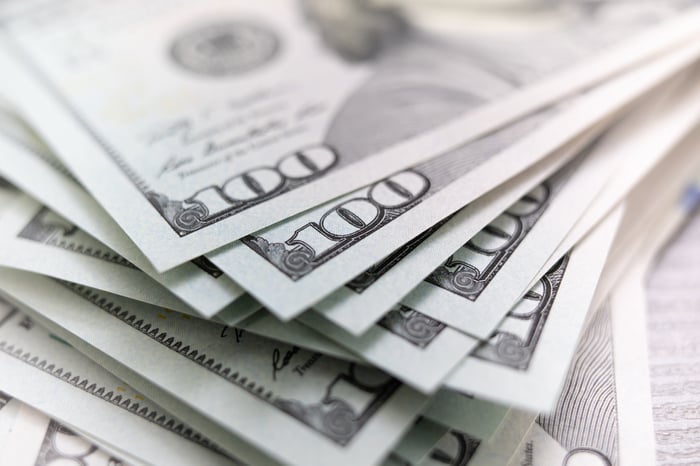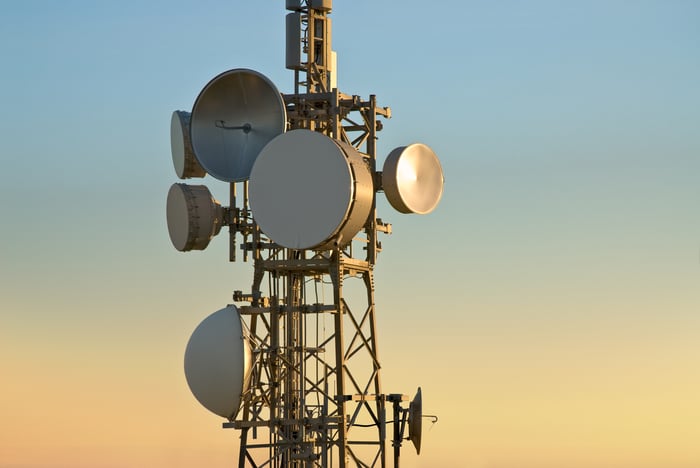For three months, Wall Street and investors have been taken for quite the ride. Panic surrounding the coronavirus disease 2019 (COVID-19) pandemic wound up pushing the benchmark S&P 500 to its fastest bear market in history, and it ultimately cost the index 34% of its value in a 33-calendar-day stretch.
While it's common for panic selling of this nature to concern investors, it's also important to realize that every bear market in history has proved to be an excellent opportunity for long-term-minded investors to put their capital to work. Though we don't know how long stock market corrections will last, or how long it might take for a new bull market to retrace everything that was lost during a correction, the fact remains that bull market rallies eventually always put bear markets into the rearview mirror.
Thus, your mode of thinking shouldn't be, "Should I invest"? Rather, it should be, "What should I be buying?"

Image source: Getty Images.
High-yield dividend stocks might be the perfect place to put your money to work
Historically speaking, there's probably not a smarter thing you can do with your cash than to buy dividend stocks. According to a report released in 2013 by J.P. Morgan Asset Management, companies that initiated and grew their payouts between 1972 and 2012 returned an average of 9.5% per year over this 40-year period. Meanwhile, non-dividend-paying stocks delivered less-than-stellar annual returns of 1.6% over the same time frame.
Aside from having time-tested and proven business models, dividend stocks bring other advantages to the table for income seekers. For example, they can help investors keep a level head. Though a dividend payout is rarely going to offset a move lower in the market, the simple fact that a company is willing to continue sharing a percentage of its profits with shareholders should boost investors' confidence and keep them from making a rash decisions, such as selling during a short-term panic.
Payouts can also be reinvested back into more shares of dividend-paying stock via a dividend reinvestment plan, or DRIP. By reinvesting your payouts, you'll wind up with a growing number of shares, and therefore even larger future payouts. A DRIP allows investors to more rapidly compound their wealth, with the strategy employed by a number of top-tier money managers.
Best of all, you don't need to be Warren Buffett to make consistent bank from dividend stocks. Having even $5,000 in disposable income that isn't needed for bills or your emergency fund is more than enough to provide an income boost to your portfolio.
Here are three exceptionally inexpensive high-yield dividend stocks to consider investing in right now.

Image source: Getty Images.
AT&T: 7.2% dividend yield
While its high-growth days are long gone, few companies can offer more predictable cash flow or a steadier dividend than telecom giant AT&T (T 0.12%). Currently boasting a 7.2% yield, AT&T has raised its payout for 36 consecutive years, placing it among a truly special group of income stocks known as Dividend Aristocrats.
Over the coming years, there are a couple of catalysts that could send AT&T and its puny forward price-to-earnings ratio of 8.6 markedly higher.
First off, there's the rollout of 5G networks, which'll be upgraded over the course of many years. Though it's costly to upgrade wireless infrastructure, it'll undoubtedly pay benefits to AT&T in the form of a long-lasting tech upgrade cycle. Since AT&T's wireless segment generates the bulk of its margin from the data side of the equation, 5G is only going to exacerbate demand for data among consumers and businesses. In other words, AT&T's wireless segment should be considerably more profitable in the years to follow.
Secondly, AT&T has an opportunity to really build up its streaming offerings. Later this week, we'll see the debut of HBO Max, which will offer more than 10,000 hours of premium content from HBO, as well as WarnerMedia's content library. That means well-known shows, cartoons, and movies. HBO Max comes in as the priciest of the streaming options at roughly $15 a month, but it's had enough hits on its hands to draw a following.
Just remember that boring businesses are often beautiful when it comes to investing.

Image source: Getty Images.
Philip Morris International: 6.8% dividend yield
As long as you're not turned off by the idea of owning vice stocks, then income seekers should really consider putting their money to work in tobacco giant Philip Morris International (PM 1.52%).
Although Philip Morris has a dividend yield that's about 3 percentage points lower than Altria Group, there's a very clear reason Philip Morris is the tobacco stock you'll want to own: geographic diversity. Altria services the United States, where adult smoking rates have hit an all-time low. Meanwhile, Philip Morris operates in over 180 countries worldwide. Even though some of the developed markets Philip Morris operates in have clamped down on tobacco packaging and advertising, there are just as many emerging and/or developing markets with burgeoning middle classes who crave simple luxuries like tobacco.
Another important point here is that the nicotine contained within tobacco products is a highly addictive chemical. This has allowed Philip Morris to pass along steady price hikes in order to grow its sales as cigarette shipment volumes flatten or fall.
But perhaps the most exciting growth of late for the company comes from its heated tobacco solution known as IQOS. At the end of the most recent quarter, an estimated 14.6 million people were using the IQOS device worldwide, with Philip Morris' share of the heated tobacco market climbing to 6.6%. As a whole, heated tobacco unit shipment volume skyrocketed 46% (year-over-year) during the first quarter to 16.7 billion units.
Even though its high-growth days are in the past, Philip Morris' forward price-to-earnings ratio of 12.7, along with its 6.8% yield, make it too cheap to pass up.

Image source: Getty Images.
Mobile TeleSystems: 9.9% dividend yield
A third high-yield income stock that should be considered for investors' portfolios is Russian telecom kingpin Mobile TeleSystems (MBT), which is better known as MTS. At 9.9%, MTS' yield is firmly planted in ultra-high-yield territory, and would, in theory, double an investors' money every 7.3 years with reinvestment.
On the surface, Russia doesn't look like it'd offer substantive wireless growth, especially considering the high wireless penetration rates throughout the country. But similar to AT&T, the rollout of 5G networks should lead to a lengthy tech upgrade cycle. Keep in mind that less-populated regions of Russia still have steps to climb on the infrastructure front before reaching 5G, which offers MTS an opportunity to build on its high-margin data plans.
What's more, Mobile TeleSystems has been wisely diversifying its operations beyond telecom to generate new revenue streams from its existing customers. It owns a 99.7% stake in MTS Bank, which has seen its monthly active user count grow from 14.1 million people at the end of 2018 to 20.3 million by the end of 2019. Overall, MTS Bank's total assets grew 18% last year, with gross loans rising almost 44%.
Though the Russian ruble can be a shaky currency at times, Mobile TeleSystems' forward price-to-earnings ratio of less than 9 appears to already be factoring in these concerns. Long-term income seekers would be smart to consider this cheap high-yield dividend stock for their portfolios.





